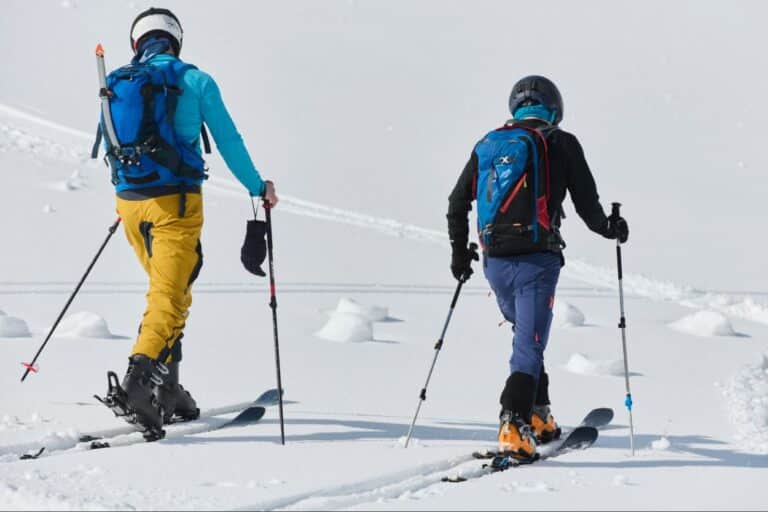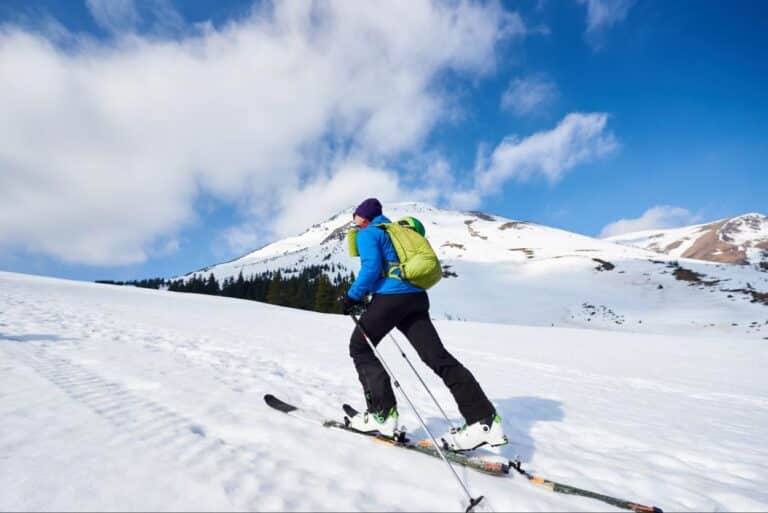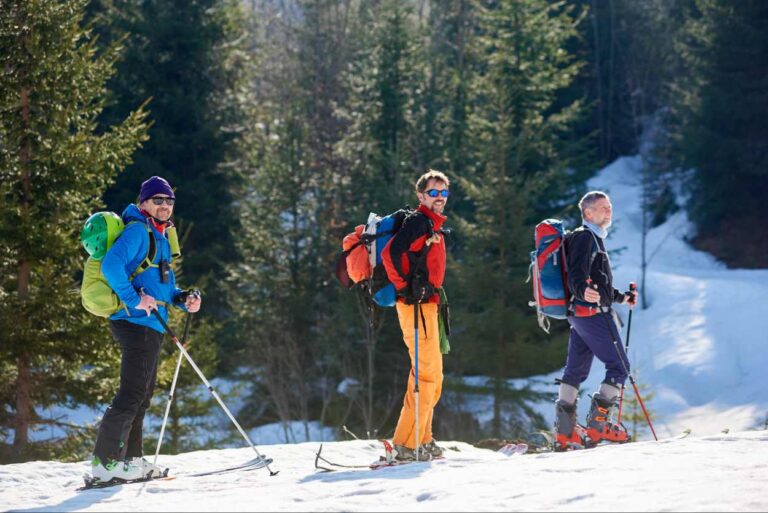More and more UK skiers are looking beyond lifts and pistes — chasing freedom, fitness, and fresh tracks. This is the essence of ski touring: climbing under your own power, then skiing down into silence and untouched snow.
Unlike resort skiing, where lifts do the work, touring is self-powered. With climbing skins on your skis, you hike uphill at your own pace. At the top, skins come off, bindings lock in, and the descent begins — often on terrain few others will touch. It’s a blend of stamina, mountain skills, and downhill flow, with rewards that are hard to match: solitude, adventure, and the chance to make the very first turns.
Like off-piste skiing, ski touring demands respect. The right equipment, sound technique, and mountain awareness are essential. But for skiers ready to expand their horizons, it opens a whole new world of winter adventure. Let’s look further into what it involves…
Ski Touring – an Overview
At its simplest, ski touring is backcountry skiing without lifts. You earn every turn.
It can be as mellow as skinning up a quiet piste before the lifts open, or as ambitious as multi-day hut-to-hut journeys across high passes and glaciers. Many start small; short climbs from resorts, while others set their sights on classics like the Haute Route from Chamonix to Zermatt.
The appeal is clear: the physical challenge of the climb, the purity of the mountains, and the thrill of skiing your own untracked line.
Skiing vs. Ski Touring: Key Differences

Think of piste skiing as racing on a smooth track, while ski touring is more like cross-country marathon running in the wild.
- Uphill effort: On-piste skiing is downhill only. Ski touring requires climbing with skins and bindings that let your heel lift as you walk.
- Pace: A day touring may involve hours of climbing for a single descent. It’s about the journey as much as the run down.
- Environment: Touring takes you beyond the lift system — into silence, solitude, and terrain where you are responsible for yourself.
- Fitness: Touring is far more demanding. If piste skiing is interval training, ski touring is endurance.
Off-Piste vs. Ski Touring: The Distinction
Many confuse off-piste with ski touring; but whilst similar they’re not the same.
- Off-piste skiing means leaving the marked runs but still using the lift system for access. You might hike short sections, but lifts do most of the work.
- Ski touring is fully self-powered. No lifts. You climb the mountain on your own, often for hours, before enjoying the descent.
In short: all ski touring is off-piste, but not all off-piste is ski touring.
Ski touring techniques
Touring blends uphill climbing with downhill skiing. Each demands its own technique and the smoother you are in both, the more energy you’ll save for enjoying the adventure.
Skinning
Instead of stomping uphill, think smooth and steady. Glide your skis forward rather than lifting, keeping strides short and controlled. This conserves energy and keeps you moving efficiently. Use your poles for rhythm; light, regular pushes that match your pace. On icy sections, press your heels down firmly to keep skins gripping.
Kick turns
These are the bread and butter of uphill switchbacks. When the slope gets too steep to continue straight, you’ll pivot one ski around, plant it, then bring the other to join. It feels clunky at first, but with practice it becomes second nature. Keep your upper body stable and eyes looking uphill to avoid losing balance mid-turn.
Efficient transitions
Switching between “climb mode” (skins on, heels free) and “ski mode” (skins off, heels locked) is an art in itself. Small tweaks like pre-folding your skins or stowing gloves where you can reach them, make the process quicker. A smooth transition not only saves time but also stops you cooling down when you pause on a windy ridge.
Downhill adjustments
Touring skis don’t ski like race-carvers on a groomed piste – and that’s a good thing. They’re lighter, sometimes narrower, and built for versatility. Stay centred over your skis, make shorter, controlled turns, and be ready to adapt to changing snowpack. Powder, crust, or slush — the fun is in reading the snow and flowing with it.
Fitness benefits of ski touring

One of the biggest challenges, and joys, of off-piste skiing is that the snow is never the same twice. One descent can be silky smooth, the next a complete battle. Learning to recognise different snow types and adapt your technique is the mark of a true freerider.
Powder
The stuff of dreams. Light, fluffy snow that billows around you as you ski, giving that effortless, floating sensation. Powder rewards a centred stance and gentle, even weight distribution on both skis. Think rhythm rather than force: bounce lightly, let the skis rise and fall, and resist the temptation to lean back. Once you find the flow, it’s the purest joy in skiing.
Crust
Crust forms when the top layer melts slightly and then refreeze, leaving a hard shell over softer snow beneath. Breaking through it can be awkward; your skis may dive suddenly or catch unpredictably. The trick is light, controlled turns and staying centred so you don’t get thrown off balance. Short, committed turns help punch through the layer without catching an edge.
Slush
Most common in spring, slush is wet, heavy snow that clings to your skis and slows you down. It requires more powerful movements and shorter turns to maintain rhythm and momentum. Keep your weight slightly forward and drive through the snow — think of it as a strength session on skis.
Crud
Crud is what powder becomes after others have skied it: uneven, chopped-up, and unpredictable. It’s not glamorous, but learning to master crud is essential. Ski aggressively, stay forward on your skis, and commit to each turn. If you’re tentative, crud will throw you around. Strong legs and a positive attitude go a long way here.
Ice
Icy sections are often unavoidable, particularly on wind-blown ridges or exposed slopes. They’re unforgiving — your edges either grip or they don’t. Keep your edges razor-sharp, stay calm, and use precise, balanced turns. On ice, it’s about control, not flair.
Mastering variable snow isn’t just survival. It’s what separates competitive, adaptable skiers from those who can only shine on corduroy pistes. Each condition is a chance to sharpen a different aspect of your skiing.
What equipment do you need for ski touring?

Touring isn’t about the latest gadgets; but it does demand specialised gear. The right kit keeps you moving efficiently uphill, confident on the descent, and safe in the backcountry. At a minimum, you’ll need:
- Touring skis: Lighter than piste skis, often with rockered tips for variable snow.
- Touring bindings: Let your heel lift on the climb, then lock down for descents.
- Climbing skins: Fabric strips with grip that stick to your skis for uphill traction.
- Touring boots: Lighter and more flexible than alpine boots, with walk/ski modes.
- Poles: Adjustable length poles are ideal — shorter for downhill, longer for climbing.
- Avalanche kit: Transceiver, shovel, probe — non-negotiable.
- Backpack: To carry skins, layers, safety kit, and snacks. Many choose airbag packs.
- Clothing: Breathable layers. You’ll sweat climbing and need warmth descending.
Optional but recommended: crampons for boots/skis, harness and rope for glacier routes, GPS or mapping apps.
How much does ski touring cost?
Ski touring isn’t cheap to start — but once you have the kit, it’s often cheaper per day than resort skiing.
- Entry-level touring kit package (skis, skins, bindings, boots): £1,200–£2,000.
- Safety gear (transceiver, shovel, probe, pack): £400–£800.
- Clothing layers: £300+.
- Guide or intro course: £80–£120 per day.
But once equipped, lift passes aren’t necessary; you can climb up beside the piste to then ski down, for free!
Where can you go ski touring?
For UK skiers, ski touring is more accessible than you might think. From quick escapes in Scotland to a vast expanse of Alpine routes, there’s a huge variety of terrain to explore — whether you’re just starting out or chasing a multi-day adventure.
Terrain
- Beside the piste
Great for beginners or first-time tourers. You can skin up the edge of a marked run and enjoy the security of resort facilities, while still getting a taste of the uphill effort.
- Cross-country trails
Flatter, rolling terrain offers a steady endurance workout. These trails are perfect for practising efficient skinning technique and building fitness before tackling steeper ground.
- Backcountry
Away from the lifts, this is where ski touring really shines. Think untouched snowfields, ridgelines, and descents far from the crowds. It requires avalanche awareness and solid navigation skills, but the reward is freedom and fresh tracks.
- Multi-day hut-to-hut
In the Alps and beyond, mountain refuges make it possible to link days of touring into one unforgettable journey. You’ll climb high passes, ski long descents, and share simple meals in cosy huts — a true rite of passage for ski tourers.
Destinations
- Scotland
When snow conditions align, the Cairngorms, Glencoe, and Ben Nevis offer excellent touring days. Weather is unpredictable, but when it comes together, the reward is huge.
- The Alps
France, Switzerland, Austria, and Italy are the spiritual home of ski touring. Chamonix, Verbier, and St. Anton all have classic routes, while quieter valleys promise solitude and adventure.
- Norway
The fjords around Lyngen and Lofoten combine sea views with long, steady tours — a unique and unforgettable setting.
- Further afield
North America, Japan, and even the Himalayas call to those looking for once-in-a-lifetime adventure.
Safety considerations
Ski touring takes you into serious mountain terrain. With the right mindset, skills, and equipment, you can manage the risks and focus on the freedom of the journey.
Avalanche awareness
Snowpack is complex, and avalanches remain the biggest hazard in backcountry skiing. Training is essential; learn how to read terrain, recognise warning signs, and use avalanche safety kit (transceiver, probe, shovel). Always check the daily avalanche bulletin, plan conservatively, and know when to turn back.
Navigation
Mountains can be unforgiving in poor visibility. Carry a map, compass, and GPS – but more importantly, know how to use them. Plot your route before you set off and have alternatives ready if weather or conditions change.
Group dynamics
Never tour alone. Touring is a team sport when it comes to safety — share decision-making, watch out for each other, and keep visual contact. A strong group communicates clearly and isn’t afraid to speak up if something feels wrong.
Weather
Storms, whiteouts, and rapid temperature shifts can transform a safe route into something dangerous in minutes. Keep an eye on forecasts before and during your tour and always build flexibility into your plan.
Emergency planning
Preparation matters. Carry a first aid kit and know the basics of mountain medicine. Learn how to call for mountain rescue in the region you’re touring, and always leave your itinerary with someone at home. A little planning can make all the difference if things don’t go to plan.
Respecting the mountain is what allows you to enjoy it. Safety isn’t about limiting your adventure — it’s what gives you the confidence to explore further.
The essence of ski touring
Ski touring is more than just skiing — it’s an all-body, all-mind experience. You work for every turn, which makes the descents taste sweeter. It’s quieter, harder, and more rewarding than piste skiing.
For UK skiers with ambition, it’s the natural next step: combining endurance, skill, and a hunger for exploration.
You’ll need Ski Touring Insurance from SportsCover Direct
Standard travel insurance or even ski insurance often doesn’t cover ski touring. If you plan to leave marked pistes or ski without lift access, check your policy carefully.
SportsCover Direct’s ski touring insurance offers various levels of cover to suit your needs. Our winter sports travel insurance includes emergency medical cover, trip cancellation, search and rescue, sports equipment and much more. Be aware that you should always ski off-piste with another person to ensure your ski touring and off-piste policy is valid, this does not have to be a guide.
Alternatively, you can select our bolt-on if you already have an insurance policy but need the specialist off-piste cover.
Find out more and get a personalised quote today. If you need any help, our team are just a phone call or email away.
This blog has been created as general information and should not be taken as advice. Make sure you have the correct level of insurance for your requirements and always review policy documentation.